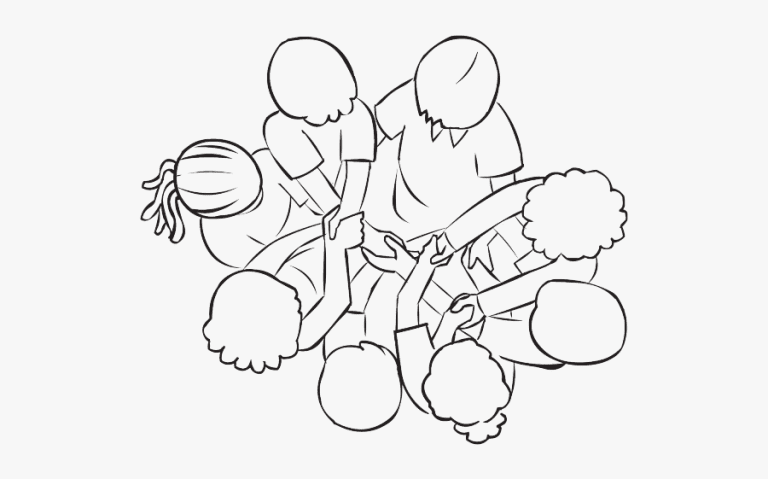We have a feeling that, along the way, youth group icebreakers have marked the beginning of lots of friendships. Not only that it’s a whole lot easier for kids to bond, but they’re also in for some fun almost every second of their life.
‘Get to know you’ games for youth can be played both indoors and outdoors, in school, to create a stronger connection between the students, or at home if your friends come over with children your kid hasn’t met yet.
How can youth group icebreakers help?
The goal of these group games is to build a spiritual community among players who are now meeting for the first time, or who are in the process of getting to know each other. These activities are meant to actually break the ice, not turn things even more awkward than before.
- They encourage kids to communicate and interact with their peers.
- They can share personal stuff and get to know each other better.
- They incite laughter and show how their sense of humor works.
- They teach kids how to behave when facing group experiences – in classrooms, camps, parties, or sleepovers.
Check out our list of icebreaker games for youth and let us know how things work out for your group! 👇🏼
1. The Newspaper Run
This is one of the most common youth group icebreaker games because it helps with remembering names.
What do you need?
- A newspaper
- A bunch of kids who still haven’t figured out each others’ names yet
How do you play?
- Everyone sits in a circle.
- One player stands in the middle of the circle with a rolled-up newspaper.
- Another player begins the game by calling out the name of someone else in the circle (e.g. ‘John’). The person in the middle runs towards John.
- Now here comes the tricky part: before being hit on the leg with the newspaper, John has to call out another name (e.g. ‘Monica’).
- The person with the newspaper then runs towards Monica.
- If Monica gets hit with the newspaper before saying another name in the circle (it can’t be John), then she becomes the person holding the newspaper.
2. The Shoe Talk
We assure you that this one’s a great ‘get to know you’ game for youth, especially if you’re looking for a camping activity. The good thing is that you can also play it as an indoor game.
What do you need?
- The players’ shoes
How do you play?
- Split the players into 2 groups.
- Get each half of the group to line up against opposite sides of the playing area.
- All the players must take off 1 shoe and make a pile of their team’s shoes.
- Have each player from one team come and select a random shoe from the other team’s pile and then find the person that shoe belongs to.
- Once they find the match, have a question ready so each person in the pair can ask each other to get to know each other a little bit better. If you’re looking for some inspo, check out our lists:
- The other team should do the same with the first team’s pile of shoes.
3. Beach Ball
… and with this one, ‘getting to know you’ games for youth have never been funnier.
What do you need?
- Obviously, a beach ball. Avoid hard-surface balls so that kids don’t get hurt.
How do you play?
- Have all the kids stand in a large circle.
- Name one player to hold the beach ball.
- That player begins by saying someone’s name and tossing the ball to that person (eg. ‘James’). James must catch the ball, repeat their first name aloud so that everyone can hear it, then share one thing about themselves (eg. ‘I’m James and I love watching cartoons’).
- Next, he must say the name of somebody else and toss it to another person in the group.
- The game keeps going until every player receives the beach ball.
- You can go for a variation of this group game right at the end of it: one more quick round to help everyone remember each other’s names. Except for this time, the thrower says, ‘this is for James who loves watching cartoons’, and tosses it to James.
- Continue until everyone has caught the ball and repeated someone’s name/fun fact for the second time.
4. Quick Line-up
This one works as a great icebreaker for teens as well.
What do you need?
- Only your players
How do you play?
- Have your kids make up 2 lines of 8-10 players each.
- Then, they can race to line up in whichever order you decide. Be creative! Here are some of the most common ‘Quick Line-up’ rules:
- Height – shortest to tallest
- Alphabetical – by mom’s first name
- Birthday month – starting with the current month
5. ‘About Me’ Jenga
Kids love a good Jenga. This game challenges their strategic thinking and also their competitive spirit. ‘About me’ Jenga is a variation of the original activity, used as a ‘getting to know you’ game for youth.
What do you need?
- A set of Jenga tumbling tower blocks or kids’ building blocks. 1 set for a group of 10-20 kids should do the trick.
How do you play?
- In this icebreaker game for youth, each block equals a question.
- If you have volunteers, you can ask them to write a conversation-starting question on each block. If you don’t have too much time on the clock, simply number every block with a permanent marker and print a numbered list of questions.
- Stack the tower in the classic Jenga-style. Start by asking one player to pull the first block. Have him/her answer the listed or corresponding numbered question to the group.
- Move to the next player until the tower falls. Don’t rush. The focus of the game is for the children to get to know each other better. Take time discussing the hobbies and mutual interests they share in between each answer.
6. Mix and Meet
This youth group icebreaker is sweet… like literally!
What do you need?
- A bunch of M&Ms, but really any sort of sweets will do, as long as they’re colorful – jelly beans, smarties, jubes, or clinkers.
How do you play?
- Give each player a handful of M&M’s and ask them not to eat them… yet!
- Then, the kids will take turns in sharing things about themselves for every chocolate they have received. The fact they share must be associated with the color of the sweet they picked.
Take a look at some of our examples. You can get as creative as you want and you can use as many topics as you like, depending on the time you have for this activity.
- Blue = Something about your friends/childhood
- Green = Something about your family/friends
- Yellow = Something about your hobbies/favorite school subjects
- Red = People/Foods/Beverages you love
- Brown = Movies/Places you like
7. How Do You Picture Yourself
This is among the most popular ‘getting to know you’ games for youth.
What do you need?
- Sheets of paper for everyone
- Pens or pencils
How do you play?
- All the players should receive a piece of paper and a pencil.
- Give them 5 minutes to draw something that shows who they are.
*Note: It doesn’t necessarily have to be a self-portrait. Also, they are not allowed to use any words or numbers.
- When they run out of time, you must collect their drawings.
- Show each picture to the group, one at a time, and have them try to guess who drew it. Ask the kids to explain how their work is representative of themselves.
8. Name Bingo
Since it’s also known as the ‘Get to know you’ bingo, you can imagine that you can’t go wrong with this one.
What do you need?
- Multiple paper sheets
- Pens or pencils
How do you play?
- First, set up the game. Create a name bingo sheet; this basically means a 5 x 5 grid of personal statements. For example, ‘has short hair’, ‘has more than one sibling’, or ‘has visited Europe’, and so on and so forth.
- Hand out these bingo sheets to each player. Give them a pen and ask them to mingle and find people that fit in the gaps.
*Note: Each player can only use another person once on their Bingo sheet.
- Usually, the game ends when one of the players completes the entire grid, but you can also give everyone a shot at ‘winning’ the game by letting everyone fill in the gaps.
9. Duck Duck Goose… But With Names
Another good ‘get to know you’ game for youth is ‘Duck Duck Goose’ because it helps kids remember each others’ names.
What do you need?
- A safe playing area. Make sure there are no pieces of furniture over which kids might trip and hurt themselves.
How do you play?
- Ask the players to sit in a circle cross-legged and face each other.
- Assign one kid to be ‘it’.
- That player starts the game by announcing their name and walks around the outside of the circle just like ‘Duck, Duck, Goose’. They have to tap each player’s head and say their name. If they reach someone whose name they don’t know, they have to say ‘You’re it!’ and run around the circle to their original seat.
- The new ‘it’ must now stand up as fast as possible, announce their name, and trade places with the ‘it’ person that tagged them. Then, they continue naming people until they get to a classmate they don’t know.
- The first player to name all the classmates in the circle wins the game.
10. Team Architect
This is a different icebreaker game for youth that tackles their creative and teamwork skills.
What do you need?
The materials you will need for this game vary depending on what you want your kids to build. For example, if you want them to build a strong bridge, you will hand them:
- A packet of pop-sticks
- A roll of sticky tape
If you want them to come up with a tall tower, make sure they have:
- Toothpicks
- Packing peanuts
OR
- Stick tape
- Newspaper
If you want to test their creativity in fashion, ask them to create a prom dress. They will need:
- Duct tape
- Tissue paper
- Feathers (optional)
If you want them to build an egg support that would stop an egg from breaking when dropped from a certain height, they will need:
- Some string
- Sheets of newspaper
How do you play?
- Group the kids in teams of 2 and start the timer. You can let them work as long as you see fit.
*However, this one’s a lot more fun and challenging when it’s turned into a ‘minute to win it’ game for kids.
11. The Pterodactyl
This is an icebreaker for youth that puts a smile on everyone’s face.
What do you need?
No materials required
How do you play?
- All the players are gathered in a circle. Each and every one of them must try to say ‘pterodactyl’ without showing their teeth and without smiling. Basically, they have to put their lips over their teeth like a person without their dentures in.
- Players can switch the direction of the game by looking at the next person and doing their best pterodactyl impression, again without showing their teeth or smiling.
- Those who crack up are out of the game.
12. Bible Flippers
This group game is similar to ‘Sword drill’.
What do you need?
- At least 2 Bibles
How do you play?
- Split the players into 2 teams. You will need two Bibles and at least several people.
- Name one player that will bring 2 people to the front and give each a Bible to hold. These players have to introduce themselves to the rest of the group.
- The announcer says a Bible verse the others must find.
- When the announcer says ‘Draw your sword’, the players can either use the Bible index or just flip around to try and find the verse.
- Whoever steps up to the announcer first and reads the verse aloud, wins that round and gets one point for their team.
- The team that has more points after 10-20 rounds wins the game.
13. Teeth
What do you need?
No materials required
How do you play?
- All the players must sit in a circle.
- Each of them has to choose a fruit or vegetable.
- Player A says their fruit/veggie, then the player’s fruit/veggie that they want to pass it on to. So, player A says “apple apple, carrot carrot” player B says “carrot carrot, blueberry blueberry”, and so on and so forth.
*Note: The trick of this game is that players must not show their teeth at any point. If anyone spots another player showing their teeth, they must yell ‘teeth teeth’ (also, without showing their teeth), and that player is automatically out of the game.
- Variation: Turn this into a better ‘getting to know each other’ game for youth by replacing the veggies and fruits with names. This way, kids will have an easier time remembering each others’ names.
14. Clap
What do you need?
No materials required
How do you play?
- The players have to stand in a circle facing toward the center.
- Each kid quickly introduces themselves to the person next to them.
- The instructor chooses one player who begins. The chosen kid must clap once.
- The person clockwise from the first clapper has to clap next.
- Here comes the tricky part: whenever a player claps once, they must keep going around the group clockwise. Whenever a player claps twice, they must change direction.
- If a player misses a clap or claps when he’s not supposed to, he’s eliminated.
15. Freeze or Lose
What do you need?
- Some pieces of clothing: T-Shirt, a hat, shorts
- Water
- A freezer
How do you play?
- Before starting the game, you have to prepare in advance a bit. Fill up some trays with water and place a t-shirt, a pair of shorts, or a hat in the water. Then, freeze it.
- Each team is given a tray. Then, they are asked to put on that item of clothing.
- The first one that manages to successfully do it, wins the challenge.
16. Quick Change Artist
What do you need?
No materials required
How do you play?
- Have 2 players come up to the front.
- Ask each one of them to observe the other’s appearance.
- Then, the players must turn around, back-to-back, and make three changes (take off a sock, untuck the shirt, tie up their hair, etc.).
- Ask them to face each other again. Now, the 2 must identify the changes made by the opponent.
- This game can be played as many times as you wish by switching partners.
*Note: Make it more challenging by increasing the number of changes they have to recognize.
17. The Human Knot
This icebreaker game for youth warms kids up to their peers and helps them feel more of a close connection with each other.
What do you need?
No materials needed
How do you play?
- Ask players to form a circle facing inwards and standing shoulder-to-shoulder.
- Each player begins by using their left hand to hold the left hand of the player next to them. Then, they cross and extend their right hand to have the person’s right hand on the other side.
- After everyone has their hands crossed, ask players to introduce themselves to their partners on each side.
- Then, ask them to untangle themselves without letting go of anyone’s hand.
*Note: They are allowed to adjust their grip, but they can not unclasp their hands.
- Use a timer for 10 minutes, and if the group has not made any progress, allow only two players to unclasp and re-clasp, then start again.
It doesn’t matter if you’re a kid, a teen, or a fully loaded grown-up. Fun is mandatory at any age. Make sure you find the perfect activities on eTeambuilding, then laugh it off with your friends from time to time!














